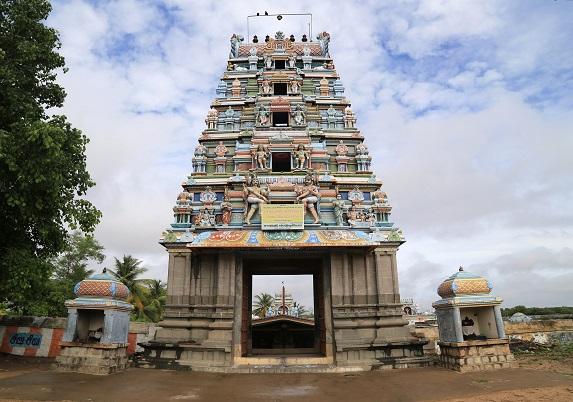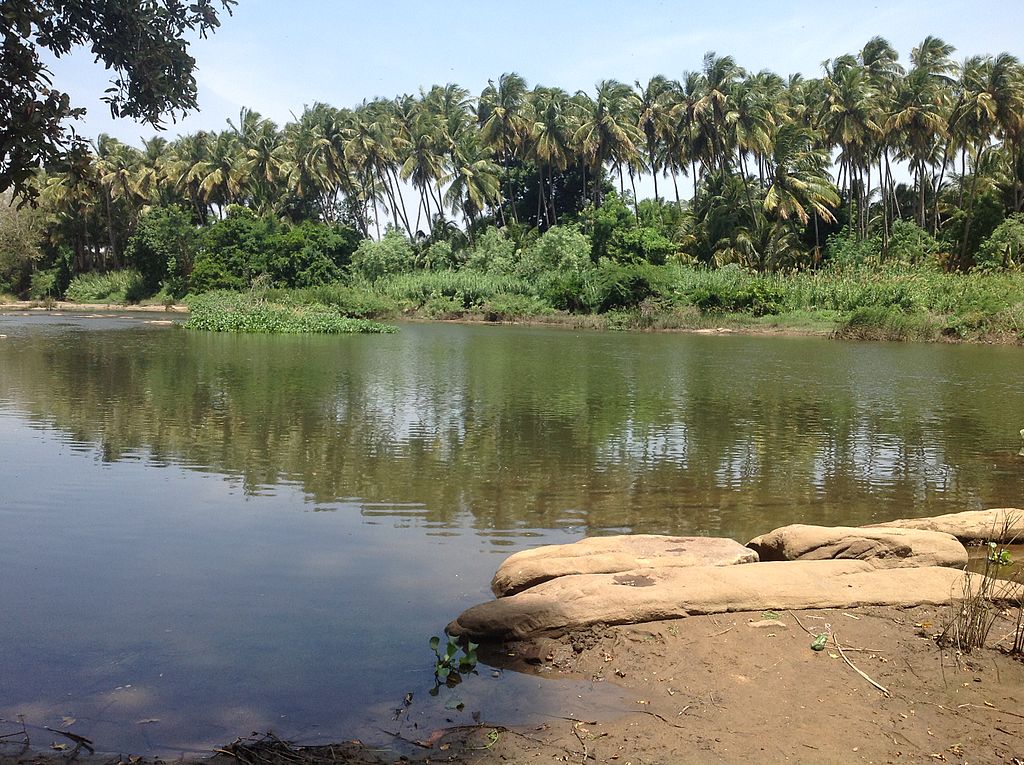Kalyana Vigirtheeswarar Temple - History and Significance
Location and Name:
This east-facing temple is situated at the confluence of the Sitraru, Kudakanaru, and a tributary of the Amaravathy River (also known as Manimutharu), which gives the place its name, Koodalur (meaning "confluence"). A hunter king named Venjaman, who ruled this region, is believed to have worshipped Lord Shiva here. As a result, the place is also called Venjamaakoodal.
HISTORY:
This east facing temple is located at the junction of rivers Sitraru and Kudakanaru and a tributary of river Amaravathy (also called Manimutharu). Hence, this place gets the name Koodalur (confluence).
A hunter king by the name of Venjaman, who ruled this place is said to have worshipped Lord Shiva here.
Hence this place is also called Venjamaakoodal.The temple was washed away by severe floods in the river Kudakanaru.
It was rebuilt in 1982.
However, this temple is still 10-12 feet below the road level, which shows the possible impact of the damages done during the flood.
Historical Events:
Flood Damage and Rebuilding:
The temple was devastated by severe floods in the Kudakanaru River in 1977, which destroyed most of its structures except for the main deity and its garbha griha (sanctum sanctorum).
It was rebuilt in 1982, but the temple remains 10-12 feet below the current road level, highlighting the extent of the flood damage.
The idol of Goddess Vigirthambika was split into two during the floods. In 1985, Thiru Muruga Kripanandavariar renovated the goddess’s sannidhi and constructed the Rajagopuram (main tower).
Further renovations, including the construction of the prakaram (corridor), compound wall, roofing of the maha mandapam, and restoration of the Bhairavar sannidhi, were completed in 2003 by Alagappa Mudaliyar and the Arul Neri Thirukootam of Erode.
Mythological Significance:
The temple is associated with the legend of Indra, the king of Devas, and Ahalya, the wife of Maharshi Gautama.
Indra's Curse:
Indra, overcome by desire for Ahalya, disguised himself as Maharshi Gautama. Ahalya, unaware of the deception, welcomed him. The sage returned early and caught Indra, who tried to escape as a cat. Maharshi Gautama cursed Indra, giving him thousands of eyes across his body.
Relief through Lord Shiva:
Seeking relief from his curse, Indra worshipped Lord Shiva at various temples. Lord Shiva, appearing as a Swayambu Linga (self-manifested Linga) here, assured Indra that his curse would fade over time. As gratitude, Indra prayed that the Lord bless devotees with His darshan from this temple.
Key Features and Renovations:
Main Deity: Lord Shiva, worshipped as Kalyana Vigirtheeswarar (a swayambu lingam).
Goddess Shrine: The sannidhi for Goddess Vigirthambika was reconstructed after the floods.
Rajagopuram: Built in 1985.
Prakaram and Maha Mandapam: Renovated in 2003.
Sacred Legends: The temple’s history reflects both mythological and natural events, making it a site of spiritual and historical importance.
PURANIC SIGNIFICANCE:
Location and Name:
The Kalyana Vigirtheeswarar Temple is located in Venjamangudalur, where the rivers Kudaganaaru and Manimutharu meet, creating a confluence. This gave the place its name Koodal Oor (confluence), later known as Venjamangudalur, named after Venjan, a hunter-king who fervently worshipped Lord Shiva and attained salvation here.
Historical Background:
The temple was originally built by Vikra, a Chera King, which is why the deity is named Vigirtheeswarar.
The temple suffered extensive damage in the 1977 floods, which destroyed much of its structure, sparing only the sanctum sanctorum (garbha griha) and the main deity.
It was rebuilt in 1982, and further renovations, including the Rajagopuram and Goddess’s shrine, were completed in 1985 under the guidance of Thiru Muruga Kripanandavariar.
Additional restoration, including the prakaram, compound wall, roof over the maha mandapam, and Bhairavar sannidhi, was undertaken in 2003 by Alagappa Mudaliyar and the Arul Neri Thirukootam of Erode.
Legends of the Temple
The temple at Venjamangudalur, associated with the legends you described, holds profound cultural and spiritual significance.
Here’s a structured overview:
Origin of Venjamangudalur
The name is derived from Venjan, a devout hunter (or in some accounts, a demon king) who attained Mukti by worshiping Lord Shiva in this region.
The village is also called Koodal Oor (meaning "confluence") due to the meeting of the rivers Kudaganaaru and Manimutharu.
Thambiran Thozhar (Lord Shiva's Friendship with Sundarar)
Saint Sundarar’s Visit: During his pilgrimage to this place, Sundarar, a revered Saivite poet, sought financial assistance from Lord Shiva.
Divine Solution: Lord Shiva, portraying his humility and affection for Sundarar, orchestrated a divine play:
Parvati appeared as an old lady to facilitate a pledge.
Lord Shiva symbolically pledged the idols of Vinayaka and Muruga to fulfill Sundarar’s financial need.
Spiritual Message: The event highlights the value of true friendship. Devotees believe that praying in this temple fosters strong relationships and friendships.
Indra’s Curse and Redemption
Indra’s Misdeed: The story of Indra coveting Akalika (or Ahalya), the wife of Sage Gautama, is central to this legend:
Disguised as a rooster, Indra tricked the sage into leaving his hermitage early.
Upon discovering the deceit, Sage Gautama cursed Indra, causing eyes to appear all over his body.
Seeking Relief: Indra visited numerous Shiva temples for forgiveness and finally received a blessing here:
Lord Shiva, as Swayambu Linga, granted Indra's desire for divine grace.
Vigirtheeswarar
The presiding deity, Vigirtheeswarar, takes his name from Vikra, a Chera king who is believed to have constructed or reconstructed the temple.
Swayambu Lingam: The lingam is self-manifested, adding to the sanctity of the temple.
Architectural Legacy: The temple showcases elements of the Chera architectural style.
OTHER PURANIC SIGNIFICANCE:
As per Kongu Mandala Sathakam, Sthala purana, Lord Shiva took the form of old man and pledged his sons Vinayagar and Subramaniyar to get gold from an old lady of this place. The gold thus obtained was given to saint Sundarar.
Key Beliefs and Benefits
Perpetuation of Relationships: Prayers in this temple are said to strengthen friendships and relationships.
Relief from Curses: Devotees seek liberation from past sins and spiritual burdens, much like Indra did.
Blessings for Mukti (Salvation): Inspired by Venjan’s devotion, worship here is believed to lead to liberation.
Historical Significance
Pandya Period Inscriptions
The temple walls, especially on the northern and southern sides and around the goddess sannidhi, are inscribed with records from the Pandya period.
These inscriptions, cataloged in the South Indian Inscription Series (143-150, 1905), include:
Sundara Pandya Thevar's rebuilding of the goddess shrine during the third regnal year of Thirubhuvana Chakravarthy Veera Pandya (1265-85 CE).
References to the prominence of the village Venjamakoodal during the 12th century.
Flood and Renovation
The temple was devastated by floods in the Kudaganaaru River and underwent extensive rebuilding in 1982, resulting in its current structure.
Presiding Deity and Beliefs
The name Vigirtheeswarar signifies the "Lord who grants all that is good."
Worshipping the deity here is believed to wash away sins and bestow blessings.
Murugan Worship
Worshipping Lord Murugan here is believed to reunite separated couples, symbolizing harmony and togetherness.
ADMINISTRATION:
The temple falls under the jurisdiction of the Executive Officer of Karur Pasupatheeswarar Temple and is well-maintained, showcasing its cultural and spiritual heritage.


